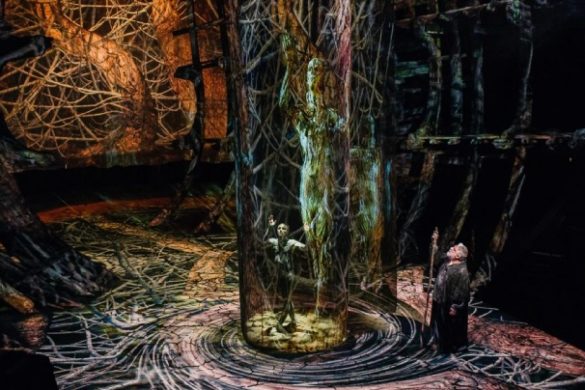A glass-walled room is on the stage, with a small desk and some cardboard boxes around it. The background is a huge screen showing a harbour and the Statue of Liberty. A middle-aged man with a suitcase walks into the room and begins telling a story of a Jewish immigrant who just arrived in the New World.
That’s how this award-winning play by Italian playwright Stefano Massini, begins. The play that in three and a half hours and with just three actors tells a 160-year family saga! Based on true events, The Lehman Trilogy brings to life the story of three brothers who started their business in the 1840s, and by 2000 it had grown into the fourth-largest investment bank in the US, which having collapsed in 2008 triggered the world financial crisis.
How can a story spanning across three generations be performed by three people? Well, that’s the wonder and beauty of this play. First of all, the actors speak in the third person, and they seamlessly blend direct speech and narration. Secondly, they transform into a different person without changes in costume or appearance, but with modulation of voice, facial expressions and mannerisms. In the blink of an eye, they become women, children or old men. Sometimes it creates a comical effect which serves to lighten the tense atmosphere of business building, moneymaking and market-dominating.
One of the miraculous transformations occurs in their accents. The narration is in British English, while individual characters all assume a specific American pronunciation, be it southern Alabama accent, or New York twang. I can’t even imagine how much thought and consideration was given to the words of each character to make it sound unique.
I always enjoy picking up on recurrent themes, those little words or symbols that spring up here and there throughout a play. In The Lehman Trilogy, one of the themes was the company name, that changed from “Lehman Fabrics and Suits”, to “Lehman Cotton”, to “Lehman Bank”, to “Lehman Finance” showing the perpetual growth and power of the family business. Another motif was a return to one’s roots, to a little shop opened by the first brother, and to Jewish traditions.
Although it’s the three actors that make the magic happen, it would be unfair not to mention the fourth component – the piano. The whole performance is accompanied by live piano music that fits the action impeccably. The score was born during the play rehearsals, so every note goes hand in hand with the words, intonations and mood of the scenes.
Although minimalist in every aspect, the play lets you travel vast distances through space and time. The Slavery age of the American South, the Civil War, railroad construction, the First World War, the creation of the stock exchange, the Great Depression, the birth of consumerism – they all flash before your eyes and leave you with the thought that even though all things come to an end, they are worth living.
- Неожиданное значение Present Perfect! - 17.01.2023
- moxie/pizazz/shenanigans – Oliver speaks (Only Murders in the building) - 17.01.2023
- In Passing/Pass/Pass by - 08.01.2023










